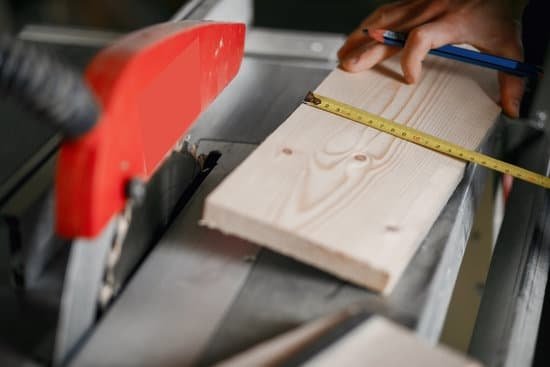Are you considering setting up a woodworking shop? Then understanding the importance of woodworking shop dimensions is crucial. From the amount of space needed to the layout and design considerations, the dimensions of your woodworking shop can greatly impact its functionality and efficiency.
Determining the ideal size for your woodworking shop involves careful consideration of various factors such as the type of projects you intend to work on, the tools and machinery you plan to use, and your available space. By finding the right balance, you can create a workspace that allows for smooth workflow and maximum productivity.
Equipping your woodworking shop with essential tools and machinery is essential for a functional workspace. From table saws to drill presses, having the right equipment not only enhances your capabilities as a woodworker but also influences the overall layout and dimensions of your shop. Understanding how these tools fit into your space is key to optimizing efficiency in your workshop.
Determining the Ideal Size for Your Woodworking Shop
When it comes to setting up a woodworking shop, one of the most important considerations is determining the ideal size for your space. The dimensions of your woodworking shop will impact the layout, functionality, and overall efficiency of your work area. Consider the following factors when determining the ideal size for your woodworking shop:
- Space for equipment and machinery: Take into account the size of your tools and machinery when planning the dimensions of your woodworking shop. Ensure that there is adequate space for table saws, planers, jointers, and other large equipment.
- Workbench areas: It’s essential to have ample space for workbenches where you can assemble and work on projects. Consider how much room you’ll need for various projects and make sure there is enough clearance around each workbench.
- Storage and organization: Factor in the necessary space for storage cabinets, tool racks, and lumber storage. Having an organized system for storing materials and tools will contribute to a more efficient workspace.
In addition to these practical considerations, it’s also important to think about future growth. As you advance in woodworking skills and take on larger projects, having some room to expand within your woodworking shop can be beneficial in avoiding limitations with your current space. Planning ahead for potential expansion can save time and effort down the road as you continue to evolve in your craft.
Ultimately, determining the ideal size for your woodworking shop involves considering all aspects of your woodworking activities – from equipment needs to future growth potential – in order to create a functional and efficient workspace that meets your specific requirements. By carefully planning the dimensions of your woodworking shop, you can create a space that not only accommodates current needs but also allows room for growth in the future.
Essential Tools and Machinery for a Functional Woodworking Shop
When it comes to setting up a functional woodworking shop, having the right tools and machinery is essential. Whether you’re a beginner or an experienced woodworker, having the proper equipment can make all the difference in the quality of your work and the efficiency of your shop. Here are some essential tools and machinery that every woodworking shop should have:
- Table Saw: A table saw is one of the most important tools in any woodworking shop. It’s versatile and can be used for a wide range of cutting tasks.
- Router: A router is essential for creating smooth edges, cutting joinery, and shaping wood.
- Compound Miter Saw: This saw is perfect for making crosscuts and miter cuts in wood, making it a valuable addition to any woodworking shop.
- Drill Press: A drill press is crucial for accurate drilling and boring holes in wood.
- Jointer and Planer: These machines are essential for flattening and squaring rough lumber, preparing it for further work.
In addition to these basic tools, there are also various hand tools that every woodworking shop should have. These include a set of chisels, hand planes, clamps, measuring tools, and more. Investing in high-quality tools will not only improve the quality of your work but also make your woodworking projects more enjoyable.
It’s important to carefully consider the space available in your woodworking shop before acquiring machinery. The size of your workshop will determine the size of equipment you can accommodate. Therefore, it’s crucial to plan your woodworking shop dimensions well in advance to ensure that there is enough space to comfortably move around while using all necessary tools and machinery effectively.
Organizing Your Space
When it comes to setting up a woodworking shop, one of the most important things to consider is the layout and design of the space. The dimensions of your woodworking shop will play a crucial role in determining how functional and efficient your workspace will be. It’s essential to carefully plan and organize your shop to ensure that it meets your needs and allows for seamless workflow.
The first step in organizing your woodworking shop is to consider the overall dimensions of the space. This includes not only the square footage of the area but also factors such as ceiling height, door and window placements, and any obstacles or structural elements that may affect the layout. For example, if you plan on working with large pieces of lumber or machinery, you’ll need adequate ceiling height and wide entrance doors for easy access.
In addition to physical dimensions, it’s important to consider the layout of your woodworking shop. This includes where you position different workstations, tools, machinery, and storage areas within the space. A well-thought-out layout can improve workflow efficiency and make it easier to move around the shop while working on projects. Consider creating designated zones for cutting, sanding, assembly, finishing, and storage to keep everything organized and easily accessible.
| Aspect | Description |
|---|---|
| Physical Dimensions | This refers to both square footage as well as ceiling height, door placements, etc. |
| Layout | Positioning workstations, tools, machinery, storage areas within the space for efficient workflow. |
Maximizing Efficiency
When it comes to maximizing efficiency in your woodworking shop, one of the most important factors to consider is the layout and design of your space. The way you organize the tools, workstations, and machinery can have a significant impact on your workflow and productivity.
One key tip for optimizing workflow in your woodworking shop is to create distinct zones for different tasks. For example, you may want to have separate areas for cutting, sanding, assembly, and finishing. This not only makes it easier to find the tools and materials you need for each specific task but also helps to minimize unnecessary movement around the shop.
Another important aspect of optimizing workflow is to ensure that your woodworking shop dimensions are well-suited to the types of projects you typically work on. If you frequently work on large pieces of furniture, you will need ample space for maneuvering and assembling these items. On the other hand, if you mainly focus on smaller items like boxes or turnings, a smaller workshop may be sufficient.
It’s also crucial to keep your most frequently used tools and materials within easy reach. This might involve installing wall-mounted tool racks or shelves, or investing in efficient storage solutions such as rolling cabinets or stackable bins. By minimizing the time it takes to locate and access what you need, you can streamline your workflow and complete projects more efficiently.
| Maximizing Efficiency Tips | Benefits |
|---|---|
| Create distinct zones for different tasks | Minimize unnecessary movement around the shop |
| Ensure that woodworking shop dimensions suit project size | Adequate space for maneuvering large pieces |
| Keep frequently used tools within easy reach | Streamline workflow and complete projects more efficiently |
Safety First
Creating a safe and hazards-free environment in your woodworking shop is crucial to ensure the well-being of yourself and anyone else who works in or visits the space. Woodworking involves sharp tools, heavy machinery, and potentially hazardous materials, so taking the necessary precautions is essential.
Investing in Proper Safety Equipment
One of the key ways to create a safe environment in your woodworking shop is by investing in proper safety equipment. This includes items such as safety goggles, hearing protection, dust masks, and fire extinguishers. Additionally, it’s important to have a first-aid kit readily available in case of any accidents or injuries.
Safeguarding Machinery and Tools
Another important aspect of creating a safe woodworking shop is ensuring that all machinery and tools are properly safeguarded. This means installing blade guards on saws, using push sticks for table saws, and keeping all tools and equipment in good working condition. Regular maintenance and inspections can help prevent accidents caused by malfunctioning machinery.
Implementing Safety Procedures
In addition to having the right equipment and safeguards in place, it’s essential to implement safety procedures for anyone working in the woodworking shop. This can include guidelines for handling sharp tools, operating machinery safely, and storing materials properly. It’s also important to provide adequate training for anyone using the woodworking shop to ensure they understand the potential hazards and how to mitigate them.
By prioritizing safety and creating a hazards-free environment in your woodworking shop, you can enjoy peace of mind while pursuing your passion for woodworking. Whether you’re a hobbyist or professional woodworker, taking these steps will help minimize the risk of accidents and injuries while working with wood.
Common Mistakes to Avoid When Planning and Designing Your Woodworking Shop
When planning and designing your woodworking shop, there are common mistakes that you should avoid in order to create a functional and efficient workspace. By being aware of these potential pitfalls, you can save yourself time, money, and frustration in the long run.
Ignoring Woodworking Shop Dimensions
One of the most critical mistakes to avoid when planning and designing your woodworking shop is ignoring the importance of dimensions. The size of your shop will greatly impact the layout, workflow, and overall functionality of the space. It’s essential to consider the amount of space needed for machinery, workbenches, storage, and maneuverability. By carefully planning the dimensions of your woodworking shop, you can ensure that it meets your needs and allows for comfortable and safe working conditions.
Overlooking Electrical and Dust Collection Needs
Another common mistake is overlooking the electrical and dust collection needs of your woodworking shop. It’s important to have an adequate number of outlets located strategically throughout the space to power machinery and tools. Additionally, implementing a proper dust collection system is crucial for maintaining a clean and healthy work environment. Failing to address these requirements can lead to safety hazards, inefficiency, and unnecessary cleanup.
Not Considering Future Expansion
Failing to consider future expansion is another mistake that many woodworkers make when designing their shops. As your skills grow and evolve, you may find that you need more space or different arrangements for machinery and work areas. By taking potential future expansion into account during the initial design phase, you can save yourself from having to overhaul your shop layout down the road.
By keeping these common mistakes in mind as you plan and design your woodworking shop, you can avoid costly errors and create a space that is well-suited to your needs now and in the future. Paying attention to factors such as woodworking shop dimensions, electrical needs, dust collection, and future expansion will result in a workshop that enhances productivity while prioritizing safety and efficiency.
Adapting to Limited Space
In conclusion, when it comes to woodworking shop dimensions, the importance of proper space planning cannot be overstated. Determining the ideal size for your woodworking shop is crucial in creating a functional and efficient workspace. Essential tools and machinery are necessary for any woodworking shop, but their arrangement within the given woodworking shop dimensions can make all the difference in the workflow and productivity.
As you work on organizing your space, layout and design considerations should not be taken lightly. Maximizing efficiency is key, and there are various tips and tricks that can help you optimize workflow within the constraints of your woodworking shop dimensions. Additionally, safety should always be a top priority – creating a safe and hazards-free environment in your woodworking shop is essential for both yourself and others who may enter your workspace.
It’s important to also be aware of common mistakes to avoid when planning and designing your woodworking shop. Lastly, if you find yourself working with limited space, there are creative solutions available for small woodworking shops that can help you make the most out of your available square footage. With careful planning and consideration of your woodworking shop dimensions, you can create a workspace that is both functional and safe, no matter the size.
Frequently Asked Questions
What Is a Good Woodworking Shop Size?
A good woodworking shop size depends on the type of projects you plan to work on and the amount of space you have available. Generally, a shop should be large enough to accommodate your tools, workbench, and lumber storage while allowing free movement.
What Is the Ideal Shop Size?
The ideal woodworking shop size varies depending on individual needs and preferences. Some woodworkers may find a 400-600 square foot shop sufficient for their projects, while others may prefer a larger space for more versatility and storage options.
How Small Can a Woodshop Be?
A woodshop can be as small as a compact area in a garage or basement, as long as it has enough room for essential tools and equipment. Many woodworkers have successfully set up functional workshops in small spaces by maximizing storage and organization techniques.

Hi everyone! I’m a woodworker and blogger, and this is my woodworking blog. In my blog, I share tips and tricks for woodworkers of all skill levels, as well as project ideas that you can try yourself.





